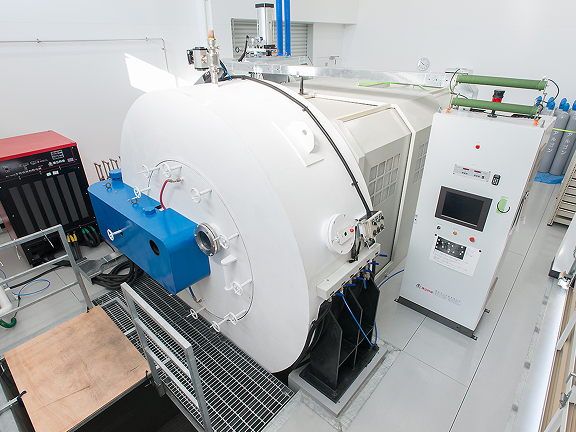
東北大学 千葉晶彦特任教授
との共同研究
東北大学 千葉晶彦名誉教授(金属材料研究所)・
未来科学技術共同研究センター 特任教授との連携
日本積層造形株式会社/JAMPT(ジャンプ)は、2017年の設立以来、千葉晶彦名誉教授(金属材料研究所)・未来科学技術共同研究センター 特任教授を技術顧問として招聘し、金属積層造形技術とプラズマ回転電極法(PREP)を中心とする材料開発を進めています。

最先端の金属3Dプリンティング技術(金属積層造形技術)と材料開発手法を日本のモノづくりへ
金属3Dプリンティング技術(金属積層造形技術)と積層造形に適した粉末の研究・開発に同時に取り組むことにより、造形品の最適化について研究しています。
具体的には、レーザー及び電子ビーム方式の金属3Dプリンターにおける造形条件の最適化に資する基礎学理を探求し、プロセス分析と最適レシピの開発に取り組んでいます。また、プラズマ回転電極法による金属粉末の特性を学理解析し、粉末の開発・製造に取り組んでいます。
東北大学の高度な研究装置を利用し、千葉研究室の材料研究ノウハウの提供と協力により、解析・評価、及び積層造形に関するシミュレーション技術を開発すると共に、材料の解析・評価を行っています。
粉末開発・製造、最適な金属組織の探索・評価、更には最適な金属加工やトポロジー最適化を含む積層造形品の設計を試みるなど、金属3Dプリンター分野における総合的なソリューションの提供を目指して研究を進めています。

金属積層造形に理想的な性質を持つPREP粉末
(当社SEM撮影、Ti-6Al-4V)

当社多賀城本社PREP製造装置
(2018年11月導入)
技術顧問 東北大学 千葉晶彦名誉教授(金属材料研究所)・
未来科学技術共同研究センター 特任教授メッセージ
革新的な金属積層造形技術で切り拓く、持続可能なものづくりの新時代~JAMPTへの期待~
金属積層造形(AM)技術は、複雑かつ精密な部品製造を可能にする革新的な技術であり、持続可能で競争力のある製造業の基盤として、ますます期待が高まっています。特に航空宇宙、自動車、医療分野においては、製品の軽量化や高性能化に貢献できる技術として産業界からも注目されています。
一方で、材料特性のばらつきや熱歪みに起因する亀裂の発生、製造プロセスにおけるコスト面の課題、品質保証に関する国際標準化の必要性など、解決すべき技術的課題も依然として存在しています。
こうした課題への対応にはさまざまな対策が求められますが、中でも特に重要なのは、粉末材料の特性を多角的かつ詳細に分析・管理することです。特にアルミニウム合金粉末などは湿気や静電気の影響を受けやすく、これらが粉末の流動性低下や水素脆化を引き起こす原因となります。
さらに、一般的に用いられるアトマイズ法で製造された金属粉末では、製造過程で使用されるアルゴンガスなどのアトマイズガスが気泡状の欠陥(ガスポア)として粉末内部にトラップされることがあり、このような粉末を使用すると造形物に多数のガス欠陥が形成され、疲労強度の低下や予期しない突然の破壊につながる可能性があります。粉末由来のこうした製品欠陥は絶対に排除しなければなりません。その点、日本積層造形株式会社(JAMPT)が活用しているプラズマ回転電極法(PREP)は、粉末製造プロセスにおいてアトマイズガスを使用しないため、ガスポアなどの気泡状欠陥をほとんど含まない高品質な金属粉末を製造できる優れた技術です。
これにより、造形品の均一性や流動性、疲労強度特性を大幅に改善するとともに、製造効率と品質の向上を実現されていることは大変評価できる成果と考えております。また、マルチマテリアル造形やトポロジー最適化技術との組み合わせによって、自動車部品をはじめとするさまざまな部材の軽量化や性能向上が可能となっていることにも注目しております。
JAMPTは、レーザー方式(L-PBF)および電子ビーム方式(EB-PBF)の両工法に関して豊富な経験と高度な専門技術を有し、部品製造の品質保証体制の確立に向けて積極的な研究開発と実用化に取り組まれています。
しかし現在、国内外における金属積層造形部品の製造はレーザー方式に偏重しており、電子ビーム方式が本来持つ、真空環境下で高融点材料や反応性材料を溶融凝固することで高品質な部材を製造できるという重要なプロセス要件が軽視される傾向にあります。
特にジェットエンジンのタービンブレードなど、安全性と信頼性が最も重要となる部材の造形では、酸化や窒化、水素脆化などの有害な影響をほぼ完全に排除できる真空環境下での造形が可能な電子ビーム方式(EB-PBF)が品質保証の観点から不可欠な工法です。
そのため、EB-PBF技術を用いた製造技術の開発と推進は極めて重要であり、この基本的なプロセス要件を踏まえ、材料特性や用途に応じてレーザー方式と電子ビーム方式を適切に使い分けるというJAMPTの基本姿勢を、今後とも緩めることなく、一層強化して推進されることを強く期待しております。
さらに、金属積層造形技術を用いたモノづくりにおいては、AIを活用したプロセスの最適化やデジタルツイン技術の導入が今後の必須課題であると考えます。
JAMPTがこうした課題にどこよりも早く着目し、積極的に取り組まれてきたことを高く評価しており、引き続きその先進的な姿勢で、製造プロセスの高度化、さらなるコスト削減、品質安定化を一層推進されることを期待しております。また、高度な専門人材の育成にも引き続きご尽力いただき、JAMPTがAM技術分野における人材育成の中心的役割を担っていかれることを願っております。
東北地域に拠点を構えるJAMPTには、地域経済の活性化や地方創生へのさらなる貢献も強く期待しております。地域の産業界や大学・研究機関との連携をさらに深め、新たな産業クラスターの形成や地域イノベーションの核として、社会的にも経済的にも意義ある発展を遂げられることを心より願っております。
今後とも、産学連携を軸に、JAMPTが金属積層造形技術のリーディングカンパニーとして、持続可能で競争力ある製造業の未来を切り拓いていかれることを今後とも強く願い、引き続き支援してまいります。
東北大学 名誉教授(金属材料研究所)
未来科学技術共同研究センター 特任教授
千葉 晶彦

東北大学 千葉晶彦名誉教授(金属材料研究所)・
未来科学技術共同研究センター 特任教授の論文紹介
金属3Dプリンター総合技術サービスを提供する当社の技術顧問・千葉特任教授による、金属積層造形に関する研究論文の一部をご紹介します。
- A method to manipulate non-steady-state columnar-to-equiaxed transition in powder bed fusion additive manufacturing using an electron beam
- Ball-milling treatment of gas-atomized Ti–48Al–2Cr–2Nb powder and its effect on preventing smoking during electron beam powder bed fusion building process
- Cracking behavior of Ti-48Al-2Cr-2Nb alloy in powder bed fusion electron beam melting process
- Detection, classification and prediction of internal defects from surface morphology data of metal parts fabricated by powder bed fusion type additive manufacturing using an electron beam
- Development of macro-defect-free PBF-EB-processed Ti–6Al–4V alloys with superior plasticity using PREP-synthesized powder and machine learning-assisted process optimization
- Effect of mechanical ball milling on the electrical and powder bed properties of gas-atomized Ti–48Al–2Cr–2Nb and elucidation of the smoke mechanism in the powder bed fusion electron beam melting process
- Factors determining the flowability and spreading quality of gas-atomized Ti-48Al-2Cr-2Nb powders in powder bed fusion additive manufacturing
- In-situ observation of powder spreading in powder bed fusion metal additive manufacturing process using particle image velocimetry
- Machine-Learning-Assisted Development of Carbon Steel With Superior Strength and Ductility Manufactured by Electron Beam Powder Bed Fusion
- Non-equilibrium solidification behavior associated with powder characteristics during electron beam additive manufacturing
- Processing condition dependency of increased layer thickness on surface quality during electron beam powder bed fusion
- Solidification behavior and porosity in electron-beam powder bed fusion of Co–Cr–Mo alloys: Effect of carbon concentrations
- 粉末床溶融結合型金属積層造形技術における金属粉末の流動性と電気的特性の関係:表面酸化皮膜の影響
- Effects of process parameters and cooling gas on powder formation during the plasma rotating electrode process
- Development of macro-defect-free PBF-EB-processed Ti–6Al–4V alloys with superior plasticity using PREP-synthesized powder and machine learning-assisted process optimization
- Effects of plasma rotating electrode process parameters on the particle size distribution and microstructure of Ti-6Al-4 V alloy powder
- Centrifugal granulation behavior in metallic powder fabrication by plasma rotating electrode process
-
電子ビーム積層造形におけるインシチュ監視による無欠陥造形技術の確立
Establishment of Defect-Free Fabrication Technology Through In-Situ Monitoring in Electron Beam Additive Manufacturing
Chiba, A.Yosetsu Gakkai Shi/Journal of the Japan Welding Society, 2024, 93(7), pp. 440–455
